All you need to know about your products!

| 3DNews Vendor Reference English Resource - All you need to know about your products! |
||||||
 |
||||||
|
|
||||||
Asus P4P800-E Deluxe (i865PE Springdale)Author:Date: 26/05/2004
Intel is experiencing certain problems with new products these days, so motherboard manufacturers are seeking ways to renew their assortments at the expense of the "old" chipsets. An example of that is Asus who released the P4P800-E Deluxe motherboard built on the i865PE chipset (has been around on the market for over a year!). At first, I thought it was a renewed version of the P4P800 Deluxe board which we tested quite thoroughly some time ago. However, upon a closer look it turned out that the PCB of P4P800-E is somehow different from the predecessor board. In particular, the number of SerialATA ports has been increased, with some controllers replaced. Note also that the board is the first product that is equipped with 8-channel audio! Another feature is the presence of a WiFi module in the package bundle. Asus P4P800-E Specifications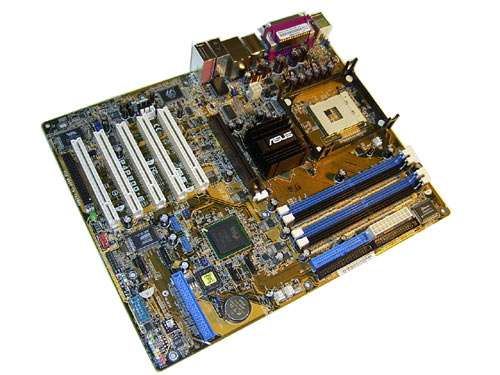
PackageThe board was packaged in a box of the following look:  One page opens like that in a book; on the centerfold, advantages of wireless connections are explained. In so doing, the user can see the Wi-Fi module through specials slits in the package.  Package bundle
I remember while we were testing the P4P800 Deluxe board, we were surprised to see a complete lack of headers (and that is strange for the very high price of the product). But the package bundle of P4P800-E gives no reasons for criticism: the box has a header for Firewire, USB 2.0 ports and a Game-port. The only port for which you would have to buy a header elsewhere is the COM-port. The user's manual did was written very well: there is a section to do with jumpers, connectors as well as description of the BIOS update procedure. There is also a section to do with the BIOS settings, the description is given in great detail; there is a description of the overclocking functions. Besides, much focus is given to the driver installation procedure and RAID array setup. 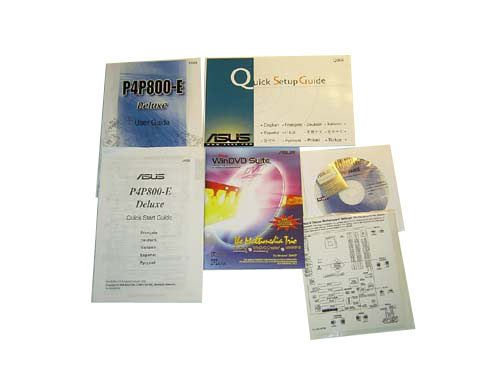 Besides, in the box there is a brief PC assembly guide (standard for all Asus motherboards), as well as a brief tuning guide for P4P800-E. There is a set of third-party software on the bundled CD. There is InterVideo WinDVD Suite on it. The remaining contents are standard: a cap to the rear panel, a pack with additional jumpers, an Asus logo, and a jumpers layout diagram. Then, there are two SerialATA cables with a power supply adapter. But the IDE cables are proprietary: black, with an Asus logo on. 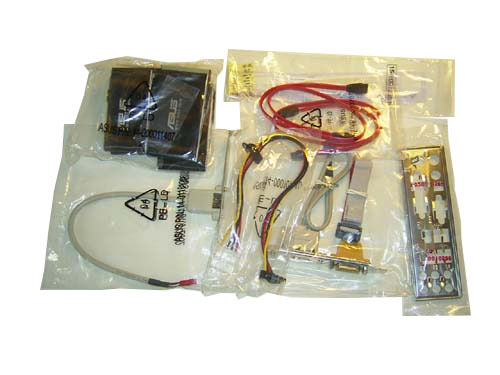 The kit of "Instant Music" stickers merits a separate mention. The Instant Music allows listening to music from CDs without loading the operating system. Finally, let's look at the kit for setting up wireless communication. 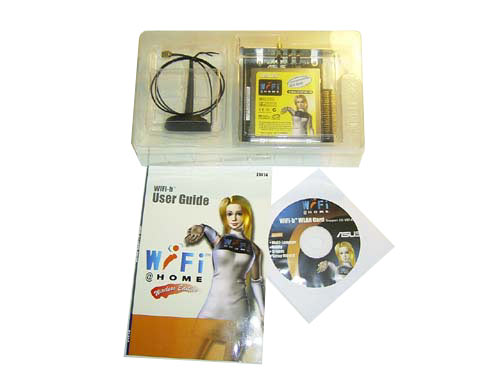 In the kit, there is the WiFi module itself (which has to be installed into a separate slot), an aerial (to be plugged in to the module), a CD with drivers and software (to be installed and tuned), a user's manual (should be read carefully to proceed with the previous steps successfully :). In the upshot: considering the relatively low price of the product, the package bundle deserved an "excellent" mark. Asus P4P800-E Board FeaturesBecause of the great number of additional controllers, the overall dimensions match the Full-ATX format (24.5 x 30 cm). Anyway, the assembly operator won't have anything to complain while fitting the board inside the PC case.  Of the shortcomings is the blockage of DIMM slots by a video card installed into the AGP slot. Besides, the additional power connector is positioned in a bit awkward way - near the chipset. But the main power connector is fit well enough - near the IDE connectors (so as not to hinder plugging in the cables).  Near the processor socket, there is the CPU_FAN connector for the cooler. Two more connectors like these are positioned near the South bridge, these are PWR_FAN and CHA_FAN. Besides, the board features support for the Q-Fan function that reduces the cooler rotational speeds as the processor temperature goes up. To reduce the noise level, there is a passive radiator installed on the North bridge.  During the tests, the radiator was pretty heated up, but I am not sure it needs active cooling (except for the hardcore overclocking). Note that it is orientated parallel to the AGP slot. Unlike the P4P800 board, such positioning does not hinder installation of video cards with massive radiators on the reverse side. If the video card has a big radiator on the front side, there aren't problems in system assembly either: the first PCI slot is moved at quite a distance from the AGP slot. 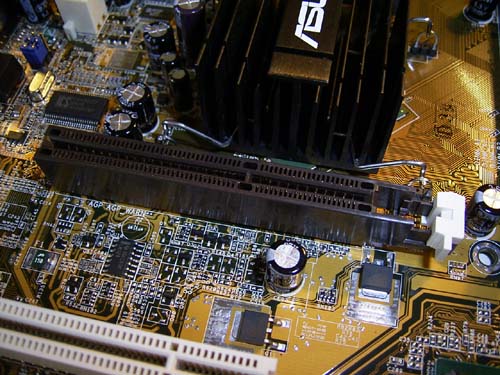 Only 1.5V AGP 4x/8x video cards are allowed into the AGP slot. But if an incompatible (i.e. a 3.3V) video card is installed, the system won't start and nothing will burn. But the red AGP Warning LED is no longer installed on modern Asus motherboards. Under the North Bridge there are 4 DIMM slots, they are partitioned into two groups - two slots in each group. The first and second slots relate to the first memory controller channel, with the third and fourth to the second channel. 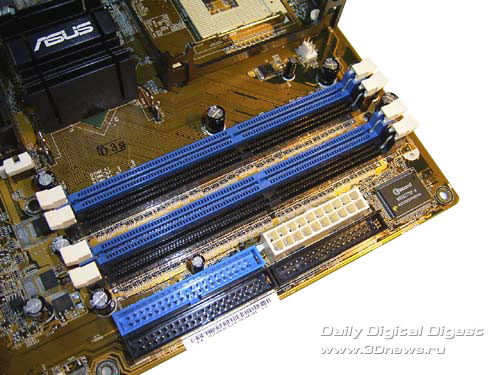 As a result, to enable the dual-channel memory access, two modules in both channels must be there. To make the assembly operator's job easier, DIMM slots are colored differently - it is recommended to install the modules into the slots of a matching color. The maximum memory capacity makes up 4 GB. If voltage is applied to the DIMM modules, then the SB_PWR LED near the last PCI slot lights up. Like in other Asus motherboards, this LED is big enough and well seen from a distance. Moving on to the PCI slots. They are five on the Asus P4P800-E.  Besides them, there is a WiFi connector (Wireless Fidelity) onboard, into which a special module (or a riser card) supporting the 802.11b (or higher) standard is inserted.  Here is a photo of the module inserted into the respective slot. 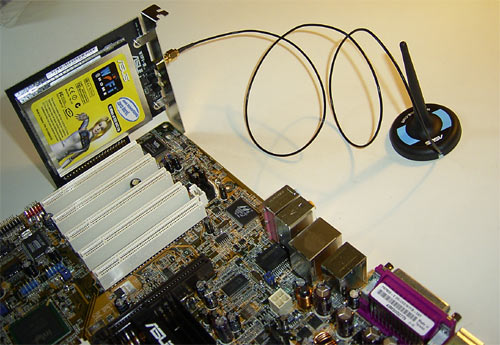 Expansion optionsOn board the P4P800-E, there is a Promise PDC20378 RAID controller with simultaneous support for ParallelATA (1 channel) and SerialATA (two channels).  As a result, the user can plug in 4 hard disks and merge them into a RAID array of level 0, 1or 0+1. Besides, one more RAID array can be arranged with the functionality of the south bridge ICH5R, which besides ParallelATA offers support for two SerialATA channels.  Ten (!) hard disks can be plugged in to Asus P4P800-E Deluxe altogether: 6 disks through the Parallel-ATA, with 4 more through the SerialATA.  Then, the board offers support for eight USB ports: four ports on the rear panel, with 4 more plugged in via headers (the board comes bundled with only 1 header for 2 ports). While the new South bridge ICH5 provides support for all the 8 USB ports, Asus engineers had to install an additional VIA VT6307 chip to enable support for the Firewire serial bus. As a result, P4P800-E acquired two Firewire ports, one of which is mounted on the rear panel, with the other one connected with a header (put in the package bundle). 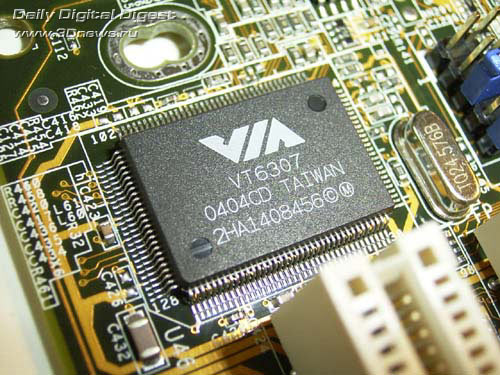 And the most exciting feature - the Asus P4P800-E offers integrated 8-channel audio on the base of the ALC850 codec made by Advance Logic.  Besides, the board offers a high-speed Marvell - 88E8001 (Gigabit Ethernet) LAN controller.  It is plugged in to the north bridge directly - via the dedicated CSA bus (Intel Communications Streaming Architecture). This makes the P4P800-E stand out among, P4P800 and P4C800 in which the Gigabit LAN chip was plugged in via a PCI bus. A few more words about the very interesting feature - AI Net. Basically, this is a diagnostic utility that allows to determine the network section in which a cable breakdown occurred or which pair of wires happened to get damaged. The utility operation range = 100 meters (i.e. just within this distance it's possible to locate the spot of rupture). Now take a look at the board's rear panel. Note the grey audio connector - lateral speakers to the 8-channel audio system are plugged in. 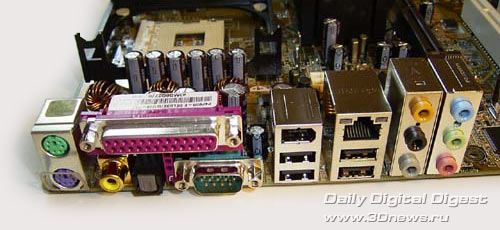 It is easy to see that there is no second COM port (in its stead, there are optical and coaxial SP/DIF outputs). Besides, there is not GAME port. Both ports should be implemented with headers, (GAME - available in the bundle, no COM). Traditionally, a jumpers layout diagram: 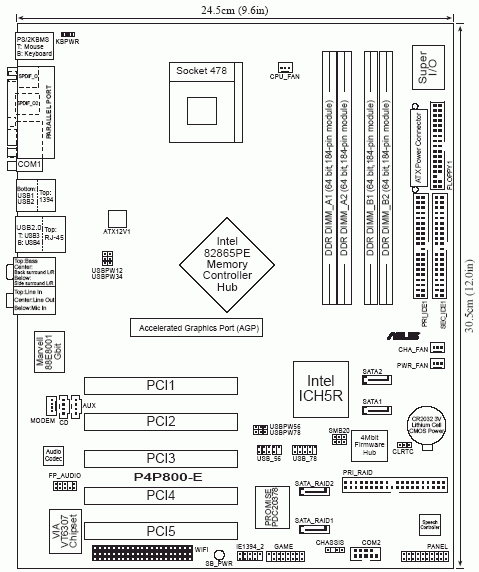 The Asus P4P800-E offers quite a few jumpers: the USBPW12-USBPW78 is meant to control the wake-up from an USB device, the KBPWR respectively for wake-up on a keyboard signal, the CLRTC is a jumper that is used to clear the CMOS (near the battery cell). Now let's take a look at the additional features implemented in the P4P800-E. First, this is the Asus POST Reporter. I have repeatedly mentioned the limitations of this feature: indistinct pronunciation, two small number of tests etc. But the other feature - CrashFree BIOS - appears to be of much more use. It allows updating the system with a new BIOS version from a diskette. Besides, on the Asus P4P800-E board there is a new (second in turn) version of this feature - now the board's BIOS can be updated from a CD as well. We can discuss a long time regarding the advantages of this function, but what matters is that now we can safely experiment and tamper with BIOS update (even from within Windows) and even delegate this procedure to the common user :). By the way, the CrashFree BIOS 2 is not the only function that allows operating the CD drive before loading the operating system. There is also the "Instant Music" feature implemented on Asus P4P800-E which turns the computer to a music CD player. The player program is hardcoded in the BIOS and to start it up, no operating system has to be loaded. Reminding it that the board comes shipped with a set of stickers attached on keys like "forward", "reverse", "play", "stop" etc. The set of functions - POST Reporter, CrashFree BIOS 2 and Q-Fan was dubbed by Asus marketing people as Ai Bios. Now on to the BIOS settings. BIOSAlthough based on the AMI Bios, the GUI of the board's BIOS screen hasn't undergone much changes as compared to that of Asus P4P800.  Let's move straight on to the section dealing with the RAM operating parameters. 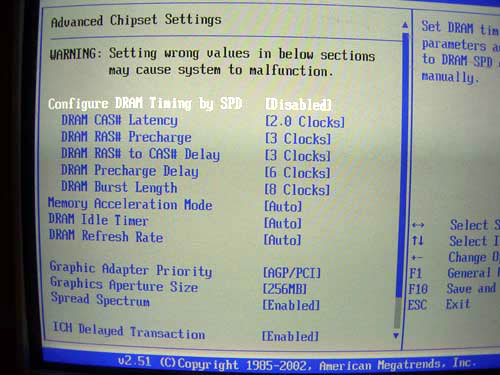 As we can see, Asustek gives the users standard options for tweaking the memory timings (accessible is the "SDRAM Cas Latency", "Precharge to Active"(Trp), "Active to precharge" (Tras) and "Active to CMD"(Trcd)). Additionally, a very interesting parameter - "Memory Acceleration Mode" - has been added which, as per Asustek's representatives, includes the PAT mode. Let me remind you that as per Intel the PAT mode is accessible solely on the 875P Canterwood chipset which gives a 3-5% performance boost. Let's verify this assumption in the section to do with performance. But the parameter responsible for setting the memory frequency is in the other section together with the overclocking tools. 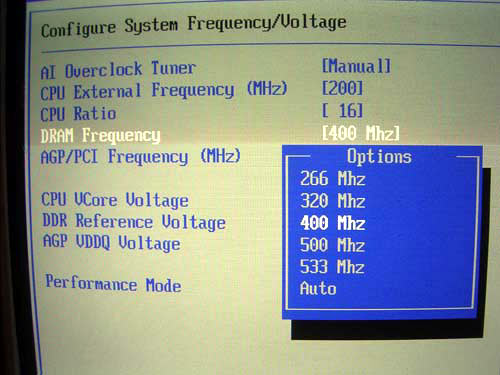 Of course, the above parameters are not the absolute values of the memory frequency, but memory divisors at FSB=200(800QP) MHz. That is, if the user sets the memory speed to "DDR400" (1:1) and then increased FSB to 250 MHz, then the memory speed will be 250 MHz respectively (DDR500; of course if the system starts up). That is, if you use memory of dubious quality, it's better to leave the synchronous mode as is, and use reducing memory divisors 2/3 and 4/5. By the way, the drop of performance in these modes is insignificant, and can be made up for with setting more demanding latency timings. Those who are keen about that read the relevant material. A few notes on the system monitoring. 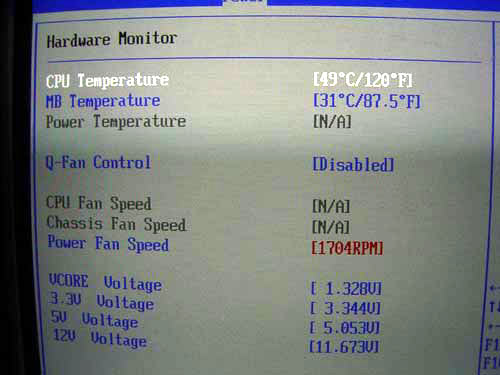 The feature-set is standard - monitored are the rotational speeds of the three fans, the processor and system temperatures, as well as the temperature read from the external sensor. There is one more function - the BIOS settings can be displayed in multiple languages: 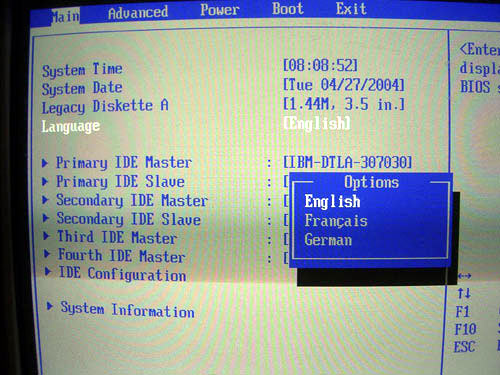 Besides, there's also the MyLogo function which allows changing the boot-up image.  Owing to the great BIOS capacity (4 Mbit), the board supports the MyLogo 2 function which allows using 256-color images. Overclocking and stabilityThere was nothing to complain about the stability of the board during the tests: the board was running round the clock both in the nominal and overclocked modes. As regards the power supply module, it is implemented following the 3-channel scheme (there are six 1500 mkF and four 1200 mkF capacitors, as well as nine MOSFETs). 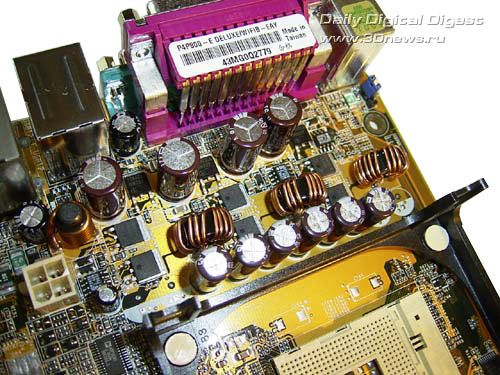 Now let's list the overclocking tools. 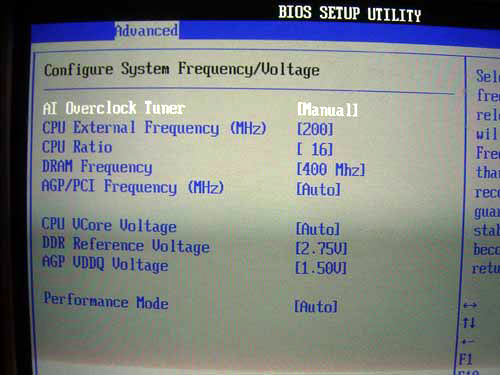 Let's first look at the FSB speed variation range, which is between 100 and 400 MHz. In so doing, the variation increment = 1MHz due to the SFS - Stepless Frequency Selection technology. Clearly, speed variation in 1MHz increments allows overclocking the processor in a very fine-tuned way and reaching the maximum possible values. But to select the right frequency, we would have to scroll through all the interim values repeatedly, which is inconvenient. The next important item is raising the processor voltage (Vcore). The Vcore variation range is within 1.35V to 1.95V in 0.025V increments. 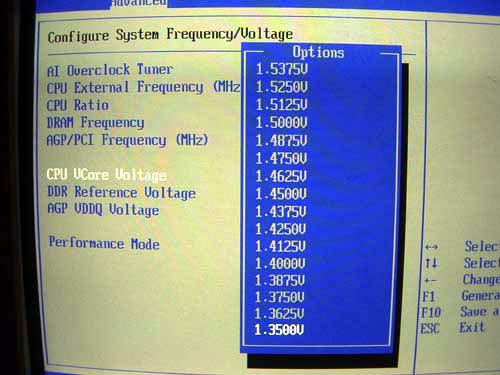 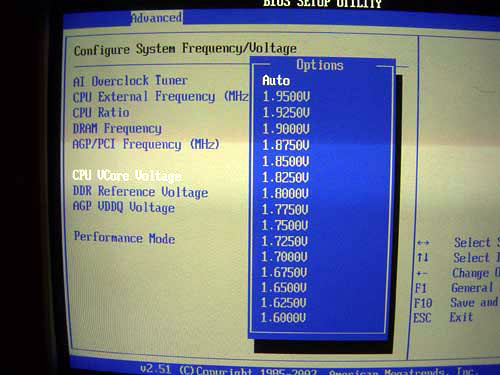 As a result, this range becomes quite sufficient for hardcore overclocking of stepping D1 & C1 Northwood processors (to overclock B0 stepping processors, it is advisable the Vcore be increased to 1.85V and higher). But to overclock Prescott processors, such a wide range of Vcore selection is absolutely unnecessary. Since processors of this type emit much heat, it is important to raise voltage with the least increment (in some boards, the increment is 0.0025V !) in order to overclock them. The next item allows raising the memory voltage (Vmem). Its variation range is between the nominal 2.55V and 2.85V (in 0.1V increments). 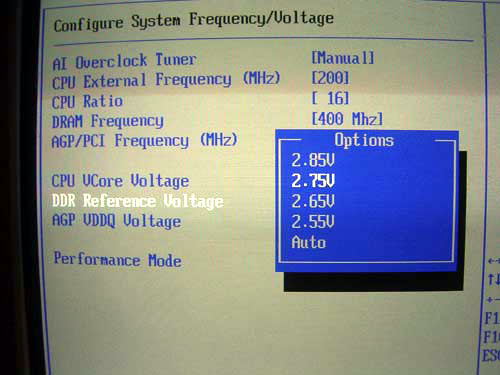 Besides, the overclocker gets a useful function for raising the AGP bus voltage. 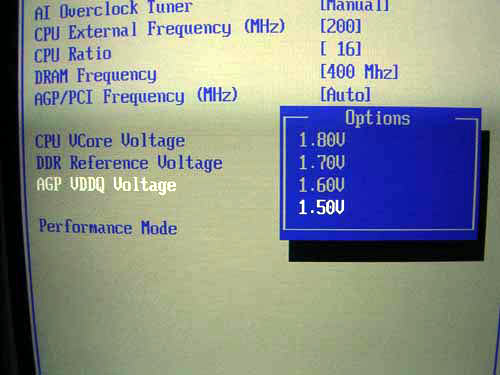 The variation range is between the nominal 1.5V and 1.8V. At increased speeds, it is important that the PCI and AGP bus speeds not depart from the standard 33 and 66 MHz, respectively, if possible. It is primarily important for correct HDD operation (and much more important for motherboards having support for RAID). So, the Asus P4P800-E board allows setting a fixed speed at the PCI and AGP buses. This parameter is adjustable within 33/66 to 40/80 MHz, respectively. 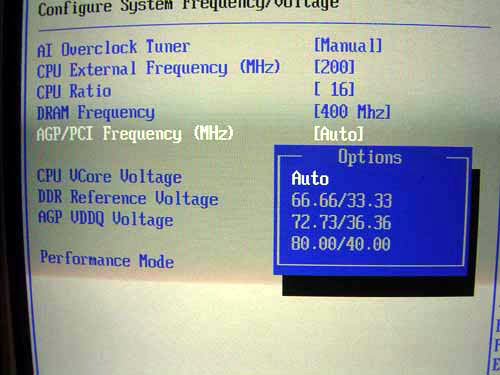 And lastly: especially for inexperienced users who are anxious to boost the performance for free, programmers at Asus have implemented the "AI Overclocking" feature. 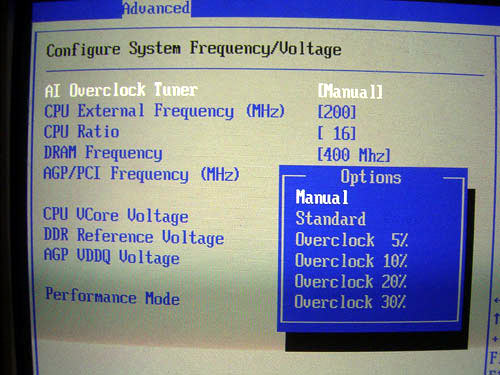 All you have to do is to select the parameters in series and check for the operational stability. General finding: the Asus P4P800-E features the most powerful overclocking tools. But I was really surprised by the practical experiment: the system was unable to run stably at FSB=300 MHz; the maximum stable FSB amounted to only 290 MHz. 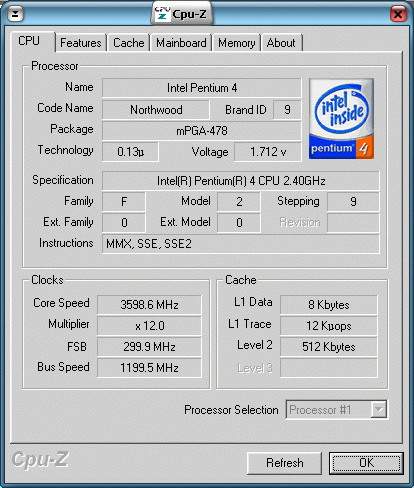 Basically, if we used a Prescott processor, then 290 MHz would be sufficient: the lowest-end processor of the family (2.8E) offers the multiplier = 14, which gives the resultant frequency 14x290=4060 MHz that is much higher than the technological limit for stepping C (~3.6 GHz). And if you come across a 2.4A processor (also based on the Prescott processor), its multiplier is even higher than that = 18. Remember that P4P800 Deluxe was the first board in our test lab which was able to cope with FSB=300 MHz. After it, the following boards were able to attain such high result: Abit IC7-G, Abit IC7-MAX3 and MSI 865PE Neo2-FIS2R. PerformanceI took Abit IC7-MAX3 (i875 Canterwood), as well as P4S800D-E (SiS 655TX) as contenders to our board in question. We'll be running two test sessions: in the first, the settings were standard, and in the second session we set the "Performance Mode" to "Aggressive" (thus allow the board to optimize the latency timings), and the "Memory Acceleration Mode" to "Enable" (this will result in the "PAT" activation, or "Hyper Path" as Asus representatives prefer to say :). In our test configuration, we used the following hardware:
Let's first take a look at the results of synthetic benchmarks. 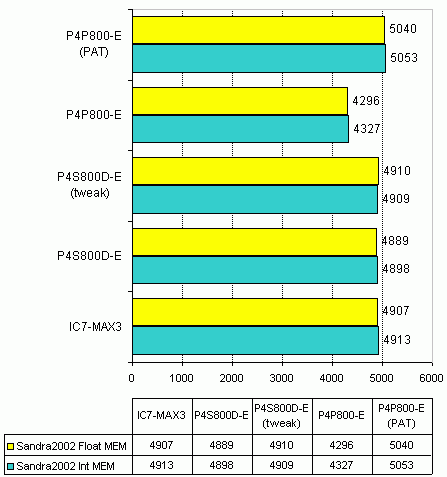 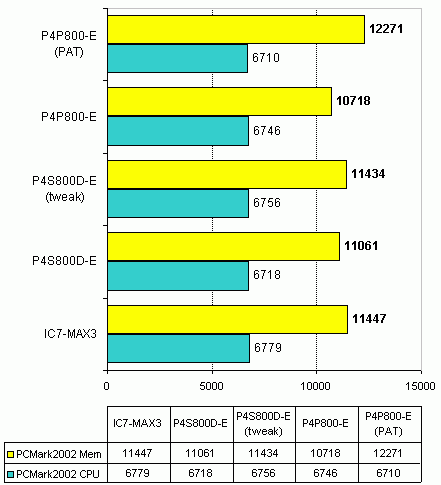 Now on to the gaming benchmarks. 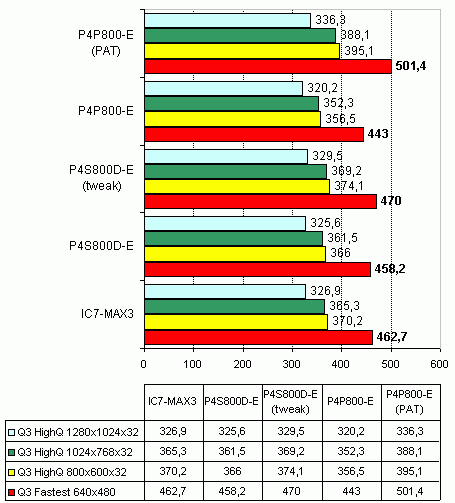 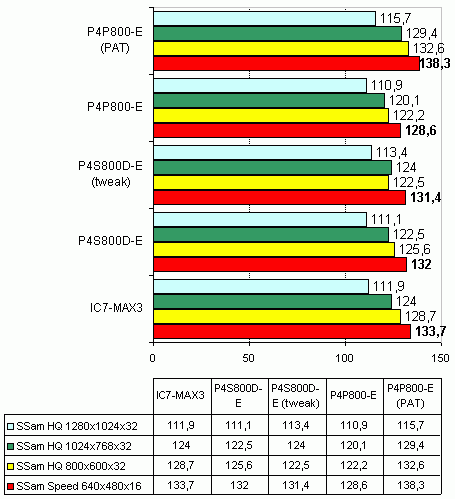 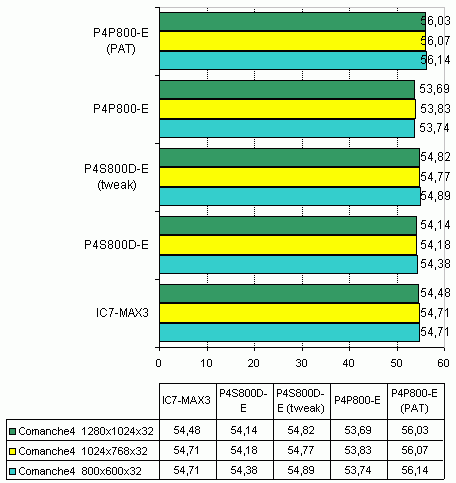 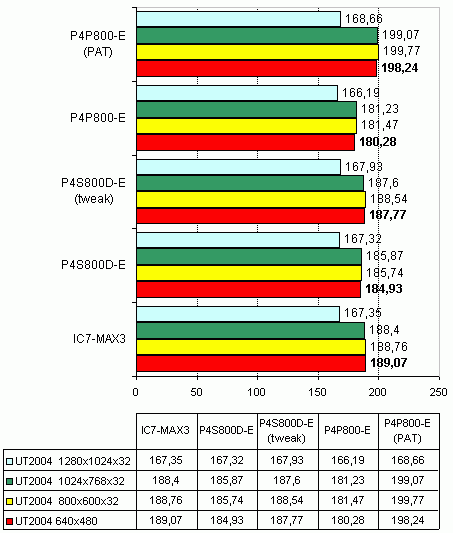 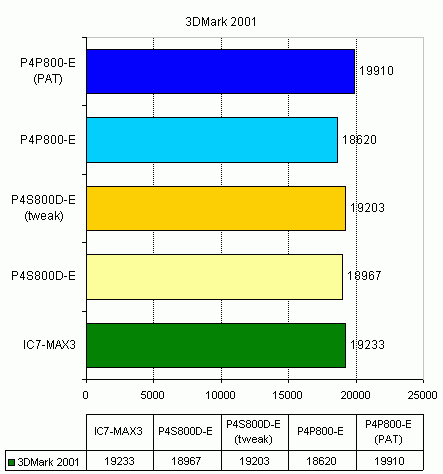 It is easy to see that enabled PAT gives quite an essential performance boost, which allows even the i865PE-based board leaving the pretty fast i875P-based motherboard behind. There is nothing to be surprised about that here: the whole line i875P\i865PE\i865P is manufactured from the same wafers. At the production stage, some small changes responsible for enabling/disabling some functions like support for ECC, PAT, FSB800 MHz bus etc. are introduced to the chips. Moreover, to enable the PAT no special RAM type is required - the standard DDR400 will do. But to set the "Memory Acceleration Mode" to "Enable", a high-quality memory is a must. In fact, again you can get by with a standard DDR400 module, but with the Vmem slightly raised. Final Words
Another plus of P4P800-E is its quite sound price, which is about $125 as per www.price.ru. With this money, the user gets an abundant package bundle, additionally to the board itself (almost all the required cables). As regards the overclocking, the board is not a top reference. Although the voltage adjustment ranges (on the processor, memory) are no worse than in other i865PE/i875P motherboards, this board does not allow to make the most of it (290 MHz of possible 300 MHz :). And lastly: the operation speed of the board is at a very high level. In fact, buying a P4P800-E, the user gets a guaranteed way to enable the PAT, and thus attain the performance level of i875P-based motherboards. ConclusionPros:
Read more on this topic |
||||||||||||||||||||||||||||||||||||||||||||||||||||||||||
|
|||||